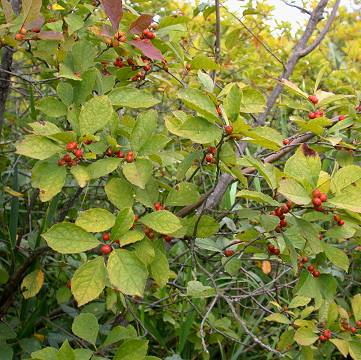

Ilex verticillata - (image 1 of 8)
Taxonomy
Family: Aquifoliaceae
Habitat
Bogs, boggy woodlands, swamps.
Associates
In bogs with Aronia prunifolia, Cephalanthus occidentalis, Chamaedaphne calyculata, Nemopanthus mucronata, Osmunda cinnamomea, Osmunda regalis spectabilis, Toxicondendron vernix, Spiraea alba, Spiraea tomentosa rosea, Vaccinum corymbosum.
Distribution
Most of the eastern half of the US.
Morphology
Medium shrub, to 15'. Leaves alternate, elliptic to obovate or oblong-lanceaolate, acute or acuminate, simple, serrate to doubly serrate, dark green above and often pubescent beneath; petiole to 1/2" long. Stems greenish to purple-brown, glabrous of finely pubescent, with lighter lenticels, can develop an onion-skin look after the first year but this is not a very reliable characteristic in my experience. Flowers dioecious, white; staminate flowers in clusters of 6 or more in the leaf axils; pistillate flowers fewer, singly or in groups of 3 on short peduncles, 4-7 parted. Fruit a bright red, berry-like drupe, to .5" across, often in pairs.
Notes
Flowers mid June to early July
Wetland indicator: Facultative wetland-
Can grow in standing water but adaptable to drier soils. Fall color is rather poor, sometimes slightly yellow or purplish. The showy fruits persist over the winter and provide a late winter food source for wildlife.
Bibliography
Dirr, Michael A. 1998. Manual of Woody Landscape Plants:
Their Identification, Ornamental Characteristics, Culture, Propagation and Uses.
5th ed. Champaign, Illinois: Stipes Publishing L.L.C.
Swink, F. and G. Wilhelm. 1994. Plants of the Chicago Region.
Indiana Academy of Science. The Morton Arboretum. Lisle, Illinois.
|
Michael Hough © 2005 |